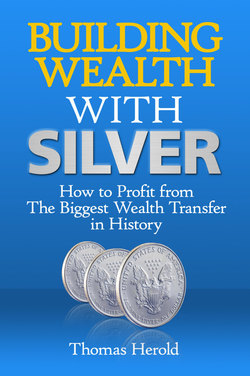Читать книгу Building Wealth with Silver - Thomas Herold - Страница 19
На сайте Литреса книга снята с продажи.
1931 – The Birth of the Fed and Beginning of the End
ОглавлениеIt may come as a surprise to you to learn that the Federal Reserve is not the original Central Bank of the United States. In fact, it is really the third Central Bank in the history of the U.S. The First Bank of the United States existed from 1791 to 1811. The Second Bank of the United States had a similar 20 year reign from 1816 to 1836.
Both banks engaged in commercial loans, took in deposits, issued currency, and bought securities. The two banks also contained a number of regional branches and performed fiscal agent duties on behalf of the United States Treasury. The biggest difference between these first two central banks and the Federal Reserve Bank lay in the fact that these other two central banks were 80 percent privately held, with stockholders voting for 80 percent of the banks’ directors.
As a result of a long standing series of financial panics and economic instabilities that culminated in the financial panic of 1907, the United States looked into creating a more stable Central Bank in the years of 1912 to 1913. There was much opposition and great debate within Congress, but the Federal Reserve Act at last passed just before the Christmas recess in 1913.
A system of twelve regional banks had been enacted in order to spread the authority of the Central Bank out between the East coast and the rest of the country. Despite this, the New York Fed became the first among equals in the new system. It maintains several privileges to this day, including engaging in open market operations as instructed by the Federal Reserve Open Market Committee.
The rise of the Federal Reserve Bank to prominence began almost immediately after its starting operations in 1915. Its first major accomplishment lay in its function in a critical role as financier of both the American and the Allied war efforts in the First World War. From this humble beginning, the Federal Reserve has only risen to greater prominence and importance in the U.S. economy and eventually that of the world.
The Federal Reserve began acquiring greater powers in the depths of the Great Depression. They began setting interest rates for the nation in an effort to influence economic growth and intervene in the severity of economic downturns.
This power was never relinquished, and is one that they maintain and use aggressively to this day.
During World War II, the Federal Reserve had to surrender some of its powers by agreeing not to raise interest rates on Treasury Bills above 0.375 percent. This compromise was made in an effort to support the war efforts, which it did heroically even after the Allies won the war. Afterward, in 1951, the Federal Reserve signed The Accord with the U.S. Treasury and regained its independence.
The Breton-Woods Agreement proved to be the turning point for the Fed in becoming an agency that had an impact on all economies of the world. This arrangement following World War II set up a new global reserve system with the reserve currency based on the dollar.
This meant that the Fed’s actions in raising and lowering interest rates now influenced the policies and currencies of all countries in the world.
In the 1970’s the Fed became obsessed with the mission of battling down inflation. Inflation had risen to out of hand levels throughout the decade, and the Federal Reserve chairman Paul Volcker made it his goal to get it under control. The Fed actually fought inflation by targeting bank reserves, another power it assumed in its march towards controlling the economy. They were so successful at this that by 1987, inflation was down to a mere percent, from its highs in the mid double digits of the 1970’s.
The Federal Reserve continues to exercise its muscles to this day. In the early years of the new century, from 2001 to 2003, they lowered interest rate thirteen times to fight recessions. From 2004 to 2006, the Fed then raised interest rates seventeen consecutive times.
In March of 2006, the Federal Reserve unilaterally decided to stop giving out the most accurate means of measuring the money supply anymore, known as M3.
With this powerful act, they had completed their destiny of growing from a limited powers organization to becoming one that could set interest rates, determine individual bank reserves, and even dictate the ways that they shared information on their activities of increasing or reducing money supply of the U.S. dollar that impacted the entire world economy.
